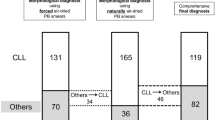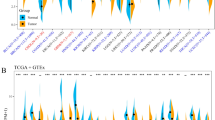Summary
The expressions and cellular distributions of two pairs of adhesion molecules CD2/LFA-3 (leukocyte function-associated antigen-3) and LFA-1/ICAM-1 (intercellular adhesion molecule-1) were examined in inflammatory cellular infiltrates of advanced squamous cell carcinomas of the head and neck by immunohistochemical techniques including double-staining methods. Thirteen patients were investigated using the following monoclonal antibodies (mAbs): CD2, LFA-3 (CD58), ICAM-1 (CD54), LFA-1 (CD11a), the alpha/beta and gamma/delta T-cell receptor, pan T cells and broadly distributed monocyte/macrophage (m/mø) [Fc gamma RII (CD32), 25F9, RM3/1]. LFA-3 staining was observed on a high number of cells (968 ± 112 cells/mm2), correlating to the number of Fe gamma RII (CD32; P < 0.01), 25F9 (P < 0.05) and RM3/1 (P < 0.05) positive m/mø. Its ligand CD2 was found on 365 ± 126 cells/mm2, representing about 50% of CD3+ cells (730 ± 286 cells/mm2). CD2 positivity correlated to CD3 and CD8 (P < 0.01) but not to CD4+ T cells. LFA-1 and ICAM-1 were expressed on lymphocytes as well as on m/mø. ICAM-1+ cells (902 ± 205 cells/mm2) correlated to CD3+, CD8+ and RM3/1+ cells (P < 0.01). LFA-1 positivity (803 ± 255 cells/mm2) showed correlations to nearly all investigated antigens, as well as to CD4+ T cells (P < 0.05). These results show that different m/mø subsets display distinct patterns of adhesion molecule expressions suggesting different pathways of regulation. The CD3+ lymphocyte population revealed a lack of CD2 expression that was more pronounced in the CD4+ subset and indicated impaired lmyphocyte function.
Similar content being viewed by others
References
Anchini A, Fossati G, Parmiani G (1987) Clonal analysis of the cytolytic T-cell response to human tumors. Immunol Today 8:385–389
Bockenstedt LK, Goldsmith MA, Dustin M, Olive D, Springer TA, Weiss A (1988) The CD2 ligand LFA-3 activates T cells but depends on the expression and the function of the antigen receptor. J Immunol 141:1904–1911
Duijvestijn A, Hamann A (1989) Mechanisms and regulation of lymphocyte migration. Immunol Today 10:23–28
Faure F, Jitsukawa S, Meuer S, Bohuon C, Triebel F, Hercend T (1988) Identification of a CD2− CD3+ T cell receptor g+ peripheral blood lymphocyte subpopulation. J Immunol 140:2128–2132
Heo DS, Whiteside TL, Johnson JT, Chen KN, Barnes EL, Herbermann RB (1987) Long term Interleukin 2-dependent growth and cytotoxic activity of tumor infiltrating lymphocytes from human squamous cell carcinomas of the head and neck. Cancer Res 47:6353–6362
Kabelitz D (1990) Do CD2 and CD3− TCR T-cell activation pathways function independently? Immunol Today 11:44–47
Kabelitz D, Conradt P, Schondelmaier S, Wagner H, Haars R (1989) A novel subset of CD2− CD3+ T cell receptor alpha/ beta+ human peripheral blood T cells. J Exp Med 170:559–569
Kornfehl J, Neuchrist C, Grasl MC, Piza H, Roka R, Ehrenberger K, Sorg C, Kraft D, Scheiner O (1992) Autotransplanted jejunum in patients with carcinomas of the head and neck: transport of immunosurveillance against neoplastic cells. Immunobiology 184:321–335
Lotzovâ E (1989) Analysis of effector mechanisms in cancer. Curr Opin Immunol 1:904–909
Makgoba MW, Sanders ME, Shaw S (1989) The CD2/LFA-3 and LFA-1/ICAM-1 pathways: relevance to T cell recognition. Immunol Today 10:417–422
Melder RJ, Whiteside TL, Vujanovic NL, Hiserodt JC, Herbermann RB (1988) A new approach to generating anti-tumor effectors for adoptive immuntherapy using human adherent lymphokine-activated killer cells. Cancer Res 48:3461–3469
Miescher S, Stoeck M, Qiao L, Barras C, Barrelet L, Fliedneer V von (1988) Preferential clonogenic deficit of CD8-positive T-lymphocytes infiltrating human tumors. Cancer Res 48:6992–6998
Mukherji B, Guha A, Chakraborty NG, Sivanandham M, Sporn JR, Ergin MT (1989) Clonal analysis of cytotoxic and regulatory T cell responses against human melanoma. J Exp Med 169:1961–1976
Neuchrist C, Grasl MC, Scheiner O, Ehrenberger K, Lassmann H, Kraft D (1991) Phenotype of mononuclear phagocytes infiltrating squamous cell carcinoma of the head and neck. Br J Cancer 62:748–753
Sanders ME, Makgoba MW, Sharrow SO, Stephany D, Springer TA, Young HA, Shaw S (1988) Human memory T lymphocytes express increased levels of three cell adhesion molecules (LFA-1, CD2 and LFA-1) and three other molecules (UCHL1, CDw29 and Pgp-1) and have enhanced IFN-gamma production. J Immunol 140:1401–1407
Sanders ME, Makgoba MW, Sussman EH, Luce GE, Cossman J, Shaw S (1988) Molecular pathways of adhesion in spontaneous rosetting of T-lymphocytes to the Hodgkin's cell line L428. Cancer Res 48:37–40
Shaw S, Luce GE (1987) The lymphocyte function-associated antigen (LFA)-1 and CD2/LAF-3 pathways of antigen independent human T cell adhesion. J Immunol 139:1037–1045
Spits H, Schooten W van, Keizer H, Seventer G van, Rijn M van de, Terhorst C, Vries JE de (1986) Alloantigen recognition is preceded by nonspecific adhesion of cytotoxic T cells and target cells. Science 232:403–405
Stoolman LM (1989) Adhesion molecules controlling lymphocyte migration. Cell 56:907–910
Topalian SL, Kasid A, Rosenberg SA (1990) Immunoselection of human melanoma resistant to specific lysis by autologous tumor-infiltrating lymphocytes. Possible mechanisms for immunotherapeutic failures. J Immunol 144:4487–4495
UICC (1987) TNM classification of malignant tumours, 4th edn. Springer, Berlin Heidelberg New York
Wawryk SO, Novotny JR, Wicks IP, Wilkinson D, Maher D, Salvaris E, Welch K, Fecondo J, Boyd AW (1989) The role of the LFA-1/ICAM-1 interaction in human leukocyte homing and adhesion. Immunol Rev 108:135–161
Author information
Authors and Affiliations
Rights and permissions
About this article
Cite this article
Kornfehl, J., Neuchrist, C., Grasp, M.C. et al. The expression and cellular distribution of adhesion molecules CD2/LFA-3 and ICAM-1/LFA-1 on mononuclear cells in squamous cell carcinoma of the head and neck. Eur Arch Otorhinolaryngol 250, 168–172 (1993). https://doi.org/10.1007/BF00171705
Received:
Accepted:
Issue Date:
DOI: https://doi.org/10.1007/BF00171705




